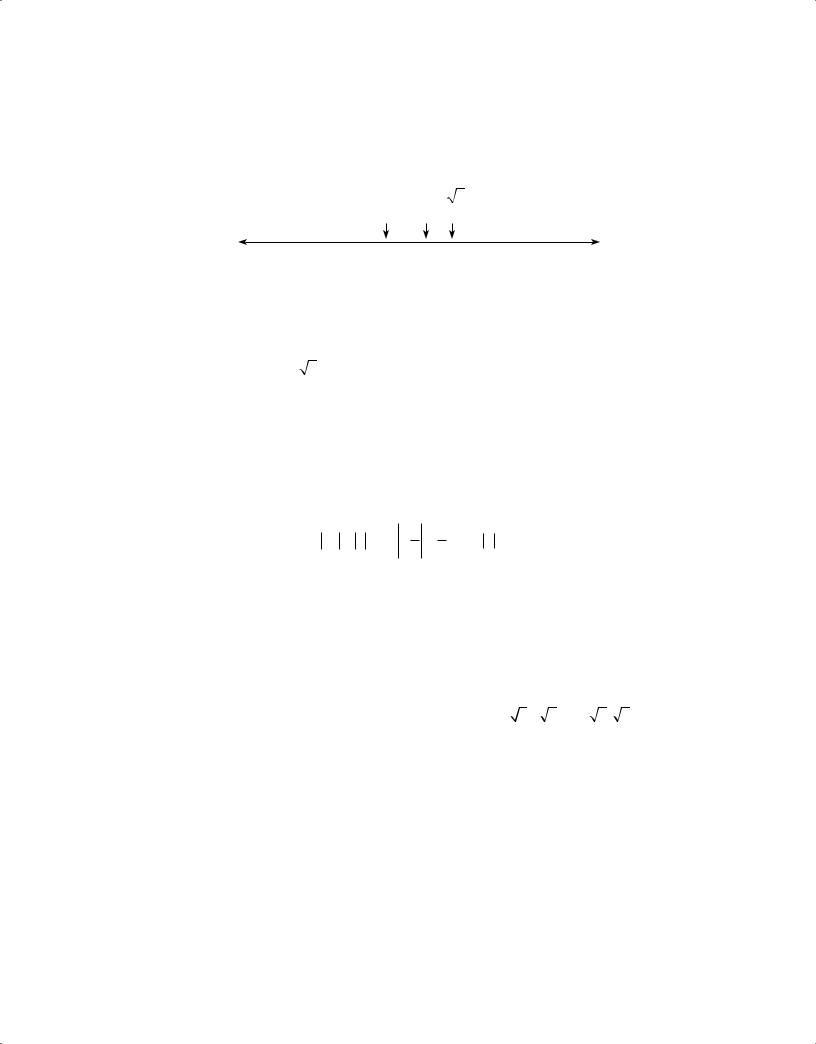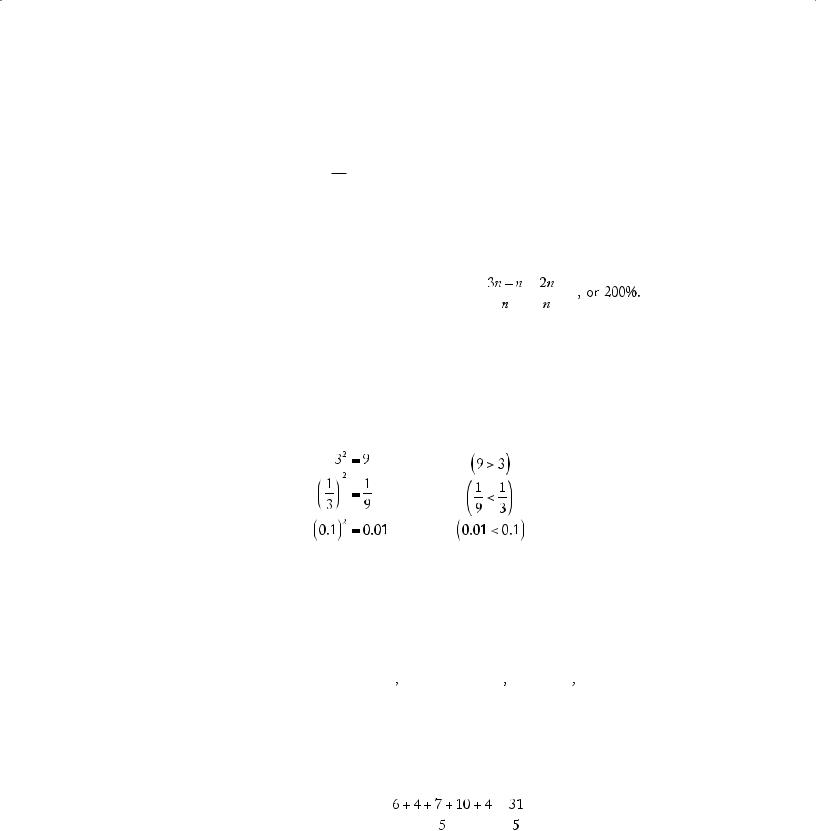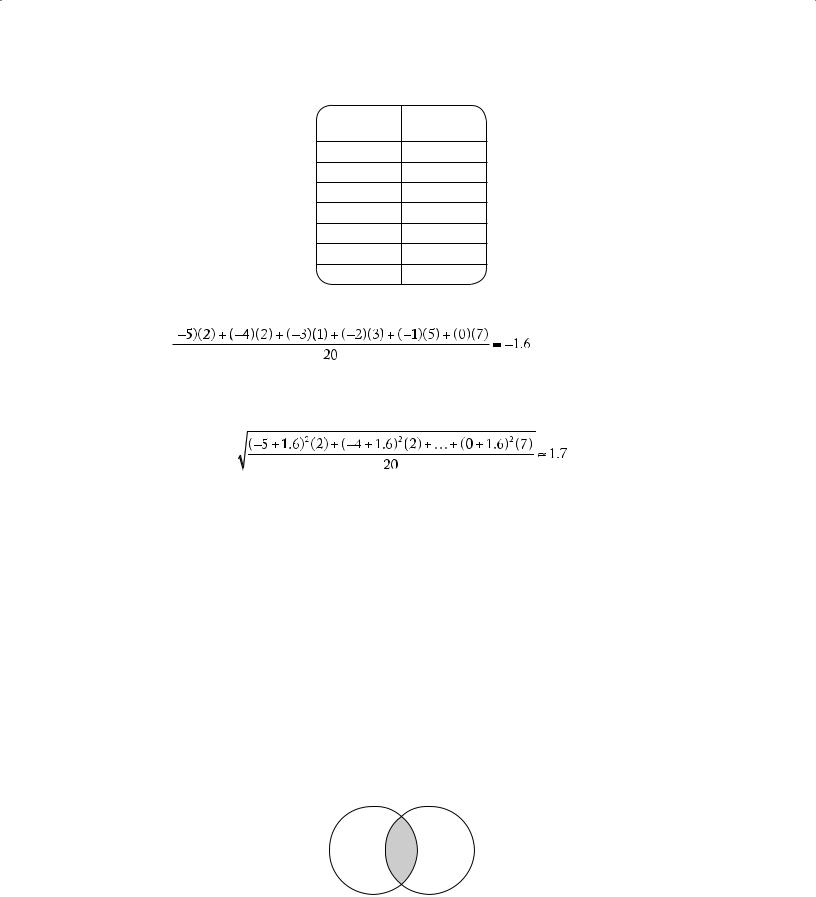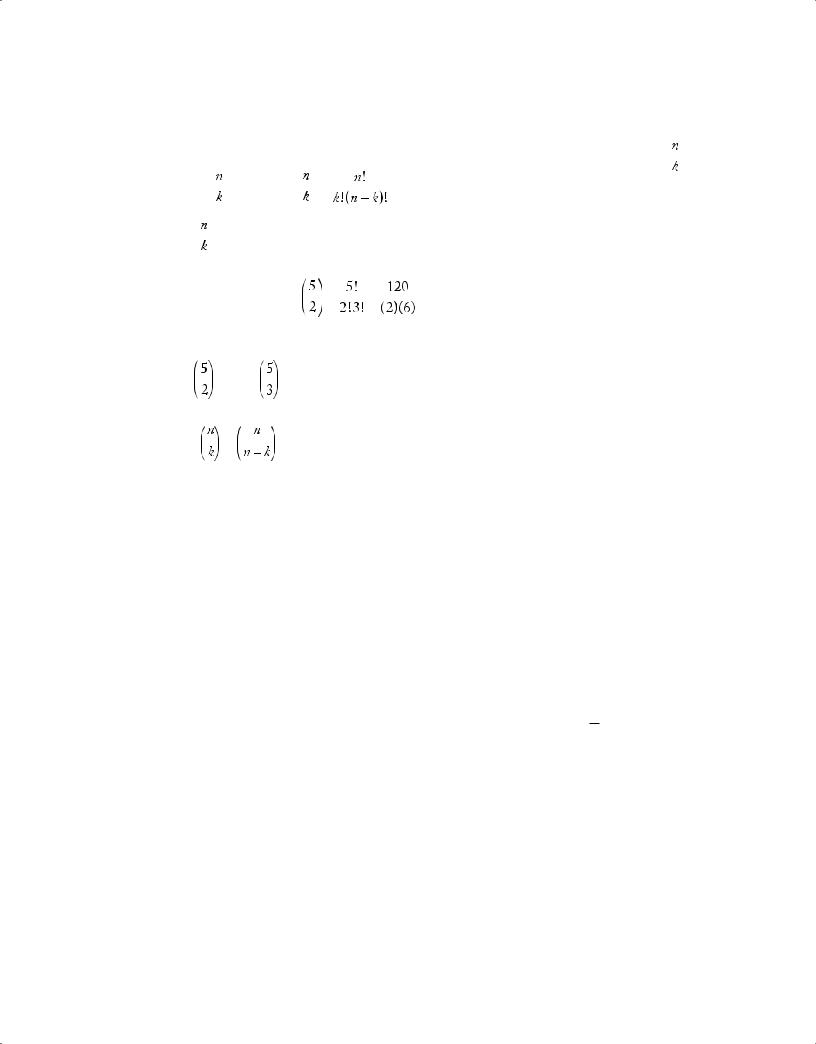
- •1.0 What Is the GMAT®?
- •1.1 Why Take the GMAT® Test?
- •1.2 GMAT® Test Format
- •1.3 What Is the Content of the Test Like?
- •1.4 Quantitative Section
- •1.5 Verbal Section
- •1.6 What Computer Skills Will I Need?
- •1.7 What Are the Test Centers Like?
- •1.8 How Are Scores Calculated?
- •1.9 Analytical Writing Assessment Scores
- •1.10 Test Development Process
- •2.0 How to Prepare
- •2.0 How to Prepare
- •2.1 How Can I Best Prepare to Take the Test?
- •2.2 What About Practice Tests?
- •2.3 How Should I Use the Diagnostic Test?
- •2.4 Where Can I Get Additional Practice?
- •2.5 General Test-Taking Suggestions
- •3.0 Diagnostic Test
- •3.0 Diagnostic Test
- •3.1 Quantitative Sample Questions
- •3.2 Verbal Sample Questions
- •3.3 Quantitative and Verbal Answer Keys
- •3.4 Interpretive Guide
- •3.5 Quantitative Answer Explanations
- •3.6 Verbal Answer Explanations
- •4.0 Math Review
- •4.0 Math Review
- •4.1 Arithmetic
- •4.2 Algebra
- •4.3 Geometry
- •4.4 Word Problems
- •5.0 Problem Solving
- •5.0 Problem Solving
- •5.1 Test-Taking Strategies
- •5.2 The Directions
- •5.3 Sample Questions
- •5.4 Answer Key
- •5.5 Answer Explanations
- •6.1 Test-Taking Strategies
- •6.2 The Directions
- •6.3 Sample Questions
- •6.4 Answer Key
- •6.5 Answer Explanations
- •7.0 Reading Comprehension
- •7.0 Reading Comprehension
- •7.1 What Is Measured
- •7.2 Test-Taking Strategies
- •7.3 The Directions
- •7.4 Sample Questions
- •7.5 Answer Key
- •7.6 Answer Explanations
- •8.0 Critical Reasoning
- •8.0 Critical Reasoning
- •8.1 What Is Measured
- •8.2 Test-Taking Strategies
- •8.3 The Directions
- •8.4 Sample Questions
- •8.5 Answer Key
- •8.6 Answer Explanations
- •9.0 Sentence Correction
- •9.0 Sentence Correction
- •9.1 Basic English Grammar Rules
- •9.2 Study Suggestions
- •9.3 What Is Measured
- •9.4 Test-Taking Strategies
- •9.5 The Directions
- •9.6 Sample Questions
- •9.7 Answer Key
- •9.8 Answer Explanations
- •10.0 Analytical Writing Assessment
- •10.0 Analytical Writing Assessment
- •10.1 What Is Measured
- •10.2 Test-Taking Strategies
- •10.3 The Directions
- •10.4 GMAT® Scoring Guide: Analysis of an Issue
- •10.5 Sample: Analysis of an Issue
- •10.6 Analysis of an Issue Sample Topics
- •10.8 Sample: Analysis of an Argument
- •10.9 Analysis of an Argument Sample Topics
- •Appendix A Percentile Ranking Tables
- •Appendix B Answer Sheets
- •Problem Solving Answer Sheet
- •Reading Comprehension Answer Sheet
- •Critical Reasoning Answer Sheet
- •Sentence Correction Answer Sheet

4.0Math Review
106

4.0 Math Review
4.0 Math Review
Although this chapter provides a review of some of the mathematical concepts of arithmetic, algebra, and geometry, it is not intended to be a textbook. You should use this chapter to familiarize yourself with the kinds of topics that are tested in the GMAT® test. You may wish to consult an arithmetic, algebra, or geometry book for a more detailed discussion of some of the topics.
Section 4.1, “Arithmetic,” includes the following topics:
1. |
Properties of Integers |
7. |
Powers and Roots of Numbers |
2. |
Fractions |
8. |
Descriptive Statistics |
3. |
Decimals |
9. |
Sets |
4. |
Real Numbers |
10. |
Counting Methods |
5. |
Ratio and Proportion |
11. |
Discrete Probability |
6. |
Percents |
|
|
Section 4.2, “Algebra,” does not extend beyond what is usually covered in a first-year high school algebra course. The topics included are as follows:
1. |
Simplifying Algebraic Expressions |
7. |
Exponents |
2. |
Equations |
8. |
Inequalities |
3. |
Solving Linear Equations with One Unknown |
9. |
Absolute Value |
4. |
Solving Two Linear Equations with |
10. |
Functions |
|
Two Unknowns |
|
|
5.Solving Equations by Factoring
6.Solving Quadratic Equations
Section 4.3, “Geometry,” is limited primarily to measurement and intuitive geometry or spatial visualization. Extensive knowledge of theorems and the ability to construct proofs, skills that are usually developed in a formal geometry course, are not tested. The topics included in this section are the following:
1. |
Lines |
6. |
Triangles |
2. |
Intersecting Lines and Angles |
7. |
Quadrilaterals |
3. |
Perpendicular Lines |
8. |
Circles |
4. |
Parallel Lines |
9. |
Rectangular Solids and Cylinders |
5. |
Polygons (Convex) |
10. |
Coordinate Geometry |
Section 4.4, “Word Problems,” presents examples of and solutions to the following types of word problems:
1. |
Rate Problems |
6. |
Profit |
2. |
Work Problems |
7. |
Sets |
3. |
Mixture Problems |
8. |
Geometry Problems |
4. |
Interest Problems |
9. |
Measurement Problems |
5. |
Discount |
10. |
Data Interpretation |
107

The Official Guide for GMAT® Review 12th Edition
4.1 Arithmetic
1.Properties of Integers
An integer is any number in the set {. . . –3, –2, –1, 0, 1, 2, 3, . . .}. If x and y are integers and x ≠ 0, then x is a divisor (factor) of y provided that y = xn for some integer n. In this case, y is also said to be divisible by x or to be a multiple of x. For example, 7 is a divisor or factor of 28 since 28 = (7)(4), but 8 is not a divisor of 28 since there is no integer n such that 28 = 8n.
If x and y are positive integers, there exist unique integers q and r, called the quotient and remainder, respectively, such that y = xq + r and 0 ≤ r < x. For example, when 28 is divided by 8, the quotient is 3 and the remainder is 4 since 28 = (8)(3) + 4. Note that y is divisible by x if and only if the remainder r is 0; for example, 32 has a remainder of 0 when divided by 8 because 32 is divisible
by 8. Also, note that when a smaller integer is divided by a larger integer, the quotient is 0 and the remainder is the smaller integer. For example, 5 divided by 7 has the quotient 0 and the remainder 5 since 5 = (7)(0) + 5.
Any integer that is divisible by 2 is an even integer; the set of even integers is
{. . . –4, –2, 0, 2, 4, 6, 8, . . .}. Integers that are not divisible by 2 are odd integers; {. . . –3, –1, 1, 3, 5, . . .} is the set of odd integers.
If at least one factor of a product of integers is even, then the product is even; otherwise the product is odd. If two integers are both even or both odd, then their sum and their di erence are even. Otherwise, their sum and their di erence are odd.
A prime number is a positive integer that has exactly two di erent positive divisors, 1 and itself. For example, 2, 3, 5, 7, 11, and 13 are prime numbers, but 15 is not, since 15 has four di erent positive divisors, 1, 3, 5, and 15. The number 1 is not a prime number since it has only one positive divisor. Every integer greater than 1 either is prime or can be uniquely expressed as a product of prime factors. For example, 14 = (2)(7), 81 = (3)(3)(3)(3), and 484 = (2)(2)(11)(11).
The numbers –2, –1, 0, 1, 2, 3, 4, 5 are consecutive integers. Consecutive integers can be represented by n, n + 1, n + 2, n + 3, . . . , where n is an integer. The numbers 0, 2, 4, 6, 8 are consecutive even integers, and 1, 3, 5, 7, 9 are consecutive odd integers. Consecutive even integers can be represented by 2n, 2n + 2, 2n + 4, . . . , and consecutive odd integers can be represented by 2n + 1, 2n + 3,
2n + 5, . . . , where n is an integer.
Properties of the integer 1. If n is any number, then 1 ∙ n = n, and for any number n ≠ 0, n ∙ n1 = 1.
n
The number 1 can be expressed in many ways; for example, n = 1 for any number n ≠ 0.
Multiplying or dividing an expression by 1, in any form, does not change the value of that expression.
Properties of the integer 0. The integer 0 is neither positive nor negative. If n is any number, then n + 0 = n and n ∙ 0 = 0. Division by 0 is not defined.
108

4.1 Math Review Arithmetic
2.Fractions
In a fraction n , n is the numerator and d is the denominator. The denominator of a fraction can never d
be 0, because division by 0 is not defined.
Two fractions are said to be equivalent if they represent the same number. For example, 8 and
14 |
|
2 |
36 |
|
are equivalent since they both represent the number |
. In each case, the fraction is reduced to |
|||
63 |
|
|||
9 |
|
|||
lowest terms by dividing both numerator and denominator by their greatest common divisor (gcd).
The gcd of 8 and 36 is 4 and the gcd of 14 and 63 is 7.
Addition and subtraction of fractions.
Two fractions with the same denominator can be added or subtracted by performing the required operation with the numerators, leaving the denominators the same. For example, 3 + 4 = 3 + 4
|
7 |
|
5 |
|
2 |
|
5 |
− |
2 |
|
3 |
|
|
|
|
5 5 |
5 |
|
= |
, and |
− |
= |
|
= |
. If two fractions do not have the same denominator, express them as |
||||||||||||
|
|
|
|
7 |
|
|
||||||||||||
5 |
7 |
7 |
|
|
7 |
|
3 |
and |
4 |
|
|
|||||||
equivalent fractions with the same denominator. For example, to add |
, multiply the |
|||||||||||||||||
5 |
7 |
|||||||||||||||||
|
|
|
|
|
|
|
|
|
|
|
|
|
|
|
|
|||
numerator and denominator of the first fraction by 7 and the numerator and denominator of the
21 |
|
20 |
|
21 |
+ |
20 |
= |
41 |
|||
second fraction by 5, obtaining |
|
|
and |
|
, respectively; |
|
|
|
. |
||
35 |
35 |
35 |
35 |
35 |
|||||||
For the new denominator, choosing the least common multiple (lcm) of the denominators 2 + 1 , the lcm of 3 and 6 is 6 (not 3 × 6 = 18), so
36
2 + 1 = 2 × 2 + 1 = 4 + 1 = 5 .
3 6 3 2 6 6 6 6
Multiplication and division of fractions.
To multiply two fractions, simply multiply the two numerators and multiply the two denominators.
For example, |
2 |
× |
4 |
= |
2 |
× 4 |
= |
8 |
. |
|
|
|
|
|
|||||
3 |
7 |
3 |
× 7 21 |
||||||
To divide by a fraction, invert the divisor (that is, find its reciprocal) and multiply. For example
|
2 |
÷ |
4 |
= |
2 |
× |
7 |
= |
14 |
= |
7 |
. |
|
|
|
|
|
|
|
|
3 |
|
|
|
|
|
|
|
|
|
|
|
|
||||||||
7 |
3 |
4 |
12 |
6 |
|
|
|
|
|
|
|
|
|
|||||||
In the problem above, the reciprocal of |
4 |
is |
7 |
. In general, the reciprocal of a fraction |
n |
is |
d |
. |
||||||||||||
|
|
|
|
|||||||||||||||||
|
|
|
|
|
|
|
|
|
|
7 |
4 |
|
d |
n |
||||||
where n and d are not zero.
109

The Official Guide for GMAT® Review 12th Edition
Mixed numbers.
A number that consists of a whole number and a fraction, for example, 7 |
2 |
, is a mixed number: |
|||||
3 |
|||||||
7 |
2 |
means 7 + |
2 |
. |
|
||
3 |
3 |
|
|
||||
|
|
|
|
|
|||
To change a mixed number into a fraction, multiply the whole number by the denominator of the fraction and add this number to the numerator of the fraction; then put the result over the
denominator of the fraction. For example, 7 |
2 |
= |
(3× 7) + 2 |
= |
23 |
. |
|
|
3 |
||||
3 |
3 |
|
|
|||
3.Decimals
In the decimal system, the position of the period or decimal point determines the place value of the digits. For example, the digits in the number 7,654.321 have the following place values:
Thousands |
|
|
Hundreds |
|
|
Tens |
|
|
|
|
Onesorunits |
|
|
|
|
Tenths |
|
Hundredths |
Thousandths |
|||||||
7 |
, |
|
6 |
5 |
|
|
|
|
4 |
. |
3 |
|
|
2 |
|
1 |
||||||||||
Some examples of decimals follow. |
3 |
|
|
|
2 |
|
|
|
|
1 |
|
|
|
321 |
|
|
||||||||||
|
0.321 |
= |
+ |
|
|
|
+ |
|
|
|
= |
|
|
|||||||||||||
|
10 |
100 |
1,000 |
1,000 |
|
|||||||||||||||||||||
|
|
|
|
|
|
|
|
|
|
|||||||||||||||||
0.0321 = |
0 |
+ |
|
3 |
|
+ |
|
|
2 |
|
+ |
|
|
|
1 |
|
|
= |
321 |
|||||||
|
100 |
|
|
|
|
10,000 |
10,000 |
|||||||||||||||||||
|
10 |
|
|
1,000 |
|
|
||||||||||||||||||||
|
1.56 = 1 + |
5 |
+ |
6 |
|
= |
156 |
|
|
|
|
|||||||||||||||
|
|
100 |
100 |
|
|
|
||||||||||||||||||||
|
|
|
|
|
|
|
|
10 |
|
|
|
|
|
|
|
|
||||||||||
Sometimes decimals are expressed as the product of a number with only one digit to the left of the decimal point and a power of 10. This is called scientific notation. For example, 231 can be written as 2.31 × 102 and 0.0231 can be written as 2.31 × 10–2. When a number is expressed in scientific notation, the exponent of the 10 indicates the number of places that the decimal point is to be moved in the number that is to be multiplied by a power of 10 in order to obtain the product. The decimal point is moved to the right if the exponent is positive and to the left if the exponent is negative. For example, 2.013 × 104 is equal to 20,130 and 1.91 × 10–4 is equal to 0.000191.
110

4.1 Math Review Arithmetic
Addition and subtraction of decimals.
To add or subtract two decimals, the decimal points of both numbers should be lined up. If one of the numbers has fewer digits to the right of the decimal point than the other, zeros may be inserted to the right of the last digit. For example, to add 17.6512 and 653.27, set up the numbers in a column and add:
17.6512
+653.2700
670.9212
Likewise for 653.27 minus 17.6512:
653.2700 −17.6512 635.6188
Multiplication of decimals.
To multiply decimals, multiply the numbers as if they were whole numbers and then insert the decimal point in the product so that the number of digits to the right of the decimal point is equal to the sum of the numbers of digits to the right of the decimal points in the numbers being multiplied. For example:
2.09(2 digits to the right)
×1.3 (1 digit to the right)
627
2090
2.717 (2 + 1 = 3 digits to the right)
Division of decimals.
To divide a number (the dividend) by a decimal (the divisor), move the decimal point of the divisor to the right until the divisor is a whole number. Then move the decimal point of the dividend the same number of places to the right, and divide as you would by a whole number. The decimal point in the quotient will be directly above the decimal point in the new dividend. For example, to divide 698.12 by 12.4:
|
12.4)698.12 |
will be replaced by: |
124)6981.2 |
and the division would proceed as follows:
56.3
124)6981.2
620
781
744
372
372
0
111

The Official Guide for GMAT® Review 12th Edition
4.Real Numbers
All real numbers correspond to points on the number line and all points on the number line correspond to real numbers. All real numbers except zero are either positive or negative.
− |
3 |
0.2 2 |
|
||
2 |
|
|
| | | | | • | |• |• | | | | |
–6 –5 –4 –3 –2 –1 0 1 2 3 4 5 6
On a number line, numbers corresponding to points to the left of zero are negative and numbers corresponding to points to the right of zero are positive. For any two numbers on the number line, the number to the left is less than the number to the right; for example,
−4 < −3 < − |
3 |
< −1, and 1 < 2 < 2. |
|
||
2 |
|
|
To say that the number n is between 1 and 4 on the number line means that n > 1 and n < 4, that is, 1 < n < 4. If n is “between 1 and 4, inclusive,” then 1 ≤ n ≤ 4.
The distance between a number and zero on the number line is called the absolute value of the number. Thus 3 and –3 have the same absolute value, 3, since they are both three units from zero.
The absolute value of 3 is denoted |3| . Examples of absolute values of numbers are
−5 = 5 = 5, − 7 = 7 , and 0 = 0 |
|
2 |
2 |
Note that the absolute value of any nonzero number is positive.
Here are some properties of real numbers that are used frequently. If x, y, and z are real numbers, then
(1) x + y = y + x and xy = yx.
For example, 8 + 3 = 3 + 8 = 11, and (17)(5) = (5)(17) = 85.
(2) (x + y) + z = x + (y + z) and (xy)z = x (yz).
For example, (7 + 5) + 2 = 7 + (5 + 2) = 7 + (7) = 14, and (5 3)( 3) = (5 3 3) = (5)(3) = 15.
(3)x(y + z) = xy + xz.
For example, 718(36) + 718(64) = 718(36 + 64) = 718(100) = 71,800.
(4)If x and y are both positive, then x + y and xy are positive.
(5)If x and y are both negative, then x + y is negative and xy is positive.
(6)If x is positive and y is negative, then xy is negative.
(7)If xy = 0, then x = 0 or y = 0. For example, 3y = 0 implies y = 0.
(8)|x + y| ≤ |x| + |y|. For example, if x = 10 and y = 2, then |x + y| = |12| = 12 = |x| + |y|; and if x = 10 and y = –2, then |x + y| = |8| = 8 < 12 = |x| + |y|.
112

4.1 Math Review Arithmetic
5.Ratio and Proportion
The ratio of the number a to the number b (b ≠ 0) is a .
b
A ratio may be expressed or represented in several ways. For example, the ratio of 2 to 3 can be written as 2 to 3, 2:3, or 2 . Th e order of the terms of a ratio is important. For example, the ratio of
3 |
|
|
|
|
4 |
|
7 |
|
the number of months with exactly 30 days to the number with exactly 31 days is |
, not |
. |
||||||
|
|
7 |
|
4 |
|
|||
A proportion is a statement that two ratios are equal; for example, |
2 |
= |
8 |
is a proportion. One way |
||||
3 |
12 |
|
|
|
|
|
||
to solve a proportion involving an unknown is to cross multiply, obtaining a new equality. For example, to solve for n in the proportion 2 = n , cross multiply, obtaining 24 = 3n; then divide
312
both sides by 3, to get n = 8.
6.Percents
Percent means per hundred or number out of 100. A percent can be represented as a fraction with a denominator of 100, or as a decimal. For example, 37% = 37 = 0.37.
100
To find a certain percent of a number, multiply the number by the percent expressed as a decimal or fraction. For example:
20% of 90 = 0.2 × 90 = 18 or
20% of 90 = 20 × 90 = 1 × 90 = 18.
100 5
Percents greater than 100%.
Percents greater than 100% are represented by numbers greater than 1. For example:
300% = 300 = 3
100
250% of 80 = 2.5 × 80 = 200.
Percents less than 1%.
The percent 0.5 % means 1 of 1 percent. For example, 0.5 % of 12 is equal to 0.005 × 12 = 0.06. 2
Percent change.
Often a problem will ask for the percent increase or decrease from one quantity to another quantity. For example, “If the price of an item increases from $24 to $30, what is the percent increase in price?” To find the percent increase, first find the amount of the increase; then divide this increase by the original amount, and express this quotient as a percent. In the example above, the percent increase would be found in the following way: the amount of the increase is (30 – 24) = 6. Therefore,
the percent increase is 6 = 0.25 = 25%. 24
113

The Official Guide for GMAT® Review 12th Edition
Likewise, to find the percent decrease (for example, the price of an item is reduced from $30 to $24), first find the amount of the decrease; then divide this decrease by the original amount, and express this quotient as a percent. In the example above, the amount of decrease is (30 – 24) = 6.
Therefore, the percent decrease is 6 = 0.20 = 20%. 30
Note that the percent increase from 24 to 30 is not the same as the percent decrease from 30 to 24.
In the following example, the increase is greater than 100 percent: If the cost of a certain house in 1983 was 300 percent of its cost in 1970, by what percent did the cost increase?
If n is the cost in 1970, then the percent increase is equal to 




7.Powers and Roots of Numbers
When a number k is to be used n times as a factor in a product, it can be expressed as kn, which means the nth power of k. For example, 22 = 2 × 2 = 4 and 23 = 2 × 2 × 2 = 8 are powers of 2.
Squaring a number that is greater than 1, or raising it to a higher power, results in a larger number; squaring a number between 0 and 1 results in a smaller number. For example:
A square root of a number n is a number that, when squared, is equal to n. The square root of a negative number is not a real number. Every positive number n has two square roots, one positive and the other negative, but  denotes the positive number whose square is n. For example,
denotes the positive number whose square is n. For example,  denotes 3. The two square roots of 9 are
denotes 3. The two square roots of 9 are  = 3 and –
= 3 and – = –3.
= –3.
Every real number r has exactly one real cube root, which is the number s such that s3 = r. The real cube root of r is denoted by 




























8.Descriptive Statistics
A list of numbers, or numerical data, can be described by various statistical measures. One of the most common of these measures is the average, or (arithmetic) mean, which locates a type of “center” for the data. The average of n numbers is defined as the sum of the n numbers divided by n. For
example, the average of 6, 4, 7, 10, and 4 is 





The median is another type of center for a list of numbers. To calculate the median of n numbers, first order the numbers from least to greatest; if n is odd, the median is defined as the middle number, whereas if n is even, the median is defined as the average of the two middle numbers. In the example above, the numbers, in order, are 4, 4, 6, 7, 10, and the median is 6, the middle number.
114

4.1 Math Review Arithmetic
For the numbers 4, 6, 6, 8, 9, 12, the median is 6 + 8 = 7. Note that the mean of these numbers is 7.5.
2
The median of a set of data can be less than, equal to, or greater than the mean. Note that for a large set of data (for example, the salaries of 800 company employees), it is often true that about half of the data is less than the median and about half of the data is greater than the median; but this is not always the case, as the following data show.
3, 5, 7, 7, 7, 7, 7, 7, 8, 9, 9, 9, 9, 10, 10
Here the median is 7, but only 2 of the data is less than the median. 15
The mode of a list of numbers is the number that occurs most frequently in the list. For example, the mode of 1, 3, 6, 4, 3, 5 is 3. A list of numbers may have more than one mode. For example, the list 1, 2, 3, 3, 3, 5, 7, 10, 10, 10, 20 has two modes, 3 and 10.
The degree to which numerical data are spread out or dispersed can be measured in many ways. The simplest measure of dispersion is the range, which is defined as the greatest value in the numerical data minus the least value. For example, the range of 11, 10, 5, 13, 21 is 21 – 5 = 16. Note how the range depends on only two values in the data.
One of the most common measures of dispersion is the standard deviation. Generally speaking, the more the data are spread away from the mean, the greater the standard deviation. The standard deviation of n numbers can be calculated as follows: (1) find the arithmetic mean, (2) find the
di erences between the mean and each of the n numbers, (3) square each of the di erences, (4) find the average of the squared di erences, and (5) take the nonnegative square root of this average. Shown below is this calculation for the data 0, 7, 8, 10, 10, which have arithmetic mean 7.
x |
x – 7 |
(x – 7)2 |
|
|
|
|
|
0 |
–7 |
49 |
|
|
|
|
|
7 |
0 |
0 |
Standard deviation |
68 |
≈ |
3.7 |
|
8 |
1 |
1 |
|||||
5 |
|
||||||
10 |
3 |
9 |
|
|
|
||
|
|
|
|
||||
10 |
3 |
9 |
|
|
|
|
|
|
Total |
68 |
|
|
|
|
Notice that the standard deviation depends on every data value, although it depends most on values that are farthest from the mean. This is why a distribution with data grouped closely around the mean will have a smaller standard deviation than will data spread far from the mean. To illustrate this, compare the data 6, 6, 6.5, 7.5, 9, which also have mean 7. Note that the numbers in the second set of data seem to be grouped more closely around the mean of 7 than the numbers in the first set.
This is reflected in the standard deviation, which is less for the second set (approximately 1.1) than for the first set (approximately 3.7).
There are many ways to display numerical data that show how the data are distributed. One simple way is with a frequency distribution, which is useful for data that have values occurring with varying frequencies. For example, the 20 numbers
–4 |
0 |
0 |
–3 |
–2 |
–1 |
–1 |
0 |
–1 |
–4 |
–1 |
–5 |
0 |
–2 |
0 |
–5 |
–2 |
0 |
0 |
–1 |
are displayed on the next page in a frequency distribution by listing each di erent value x and the frequency f with which x occurs.
115

The Official Guide for GMAT® Review 12th Edition
Data Value |
Frequency |
xf
–5 2
–4 2
–3 1
–2 3
–1 5
07
Total 20
From the frequency distribution, one can readily compute descriptive statistics:
Mean: = 
Median: –1 (the average of the 10th and 11th numbers)
Mode: 0 (the number that occurs most frequently)
Range: 0 – (–5) = 5
Standard deviation:
9.Sets
In mathematics a set is a collection of numbers or other objects. The objects are called the elements of the set. If S is a set having a finite number of elements, then the number of elements is denoted by |S|. Such a set is often defined by listing its elements; for example, S= {–5, 0, 1} is a set with |S| = 3. The order in which the elements are listed in a set does not matter; thus {–5, 0, 1} = {0, 1, –5}. If all the elements of a set S are also elements of a set T, then S is a subset of T ; for example, S = {–5, 0, 1} is a subset of T = {–5, 0, 1, 4, 10}.
For any two sets A and B, the union of A and B is the set of all elements that are in A or in B or in
both. The intersection of A and B is the set of all elements that are both in A and in B. The union
is denoted by 
 and the intersection is denoted by
and the intersection is denoted by 
 . As an example, if A = {3, 4} and
. As an example, if A = {3, 4} and
B = {4, 5, 6}, then 
 = {3, 4, 5, 6} and
= {3, 4, 5, 6} and 
 = {4}. Two sets that have no elements in common are said to be disjoint or mutually exclusive.
= {4}. Two sets that have no elements in common are said to be disjoint or mutually exclusive.
The relationship between sets is often illustrated with a Venn diagram in which sets are represented
by regions in a plane. For two sets S and T that are not disjoint and neither is a subset of the other, the intersection 
 is represented by the shaded region of the diagram below.
is represented by the shaded region of the diagram below.
ST
This diagram illustrates a fact about any two finite sets S and T : the number of elements in their union equals the sum of their individual numbers of elements minus the number of elements in their intersection (because the latter are counted twice in the sum); more concisely,
116

4.1 Math Review Arithmetic
S T = S + T − S ∩T .
This counting method is called the general addition rule for two sets. As a special case, if S and T are disjoint, then
S T = S + T
since S ∩T = 0.
10.Counting Methods
There are some useful methods for counting objects and sets of objects without actually listing the elements to be counted. The following principle of multiplication is fundamental to these methods.
If an object is to be chosen from a set of m objects and a second object is to be chosen from a di erent set of n objects, then there are mn ways of choosing both objects simultaneously.
As an example, suppose the objects are items on a menu. If a meal consists of one entree and one dessert and there are 5 entrees and 3 desserts on the menu, then there are 5 × 3 = 15 di erent meals that can be ordered from the menu. As another example, each time a coin is flipped, there are two possible outcomes, heads and tails. If an experiment consists of 8 consecutive coin flips, then the experiment has 28 possible outcomes, where each of these outcomes is a list of heads and tails in some order.
A symbol that is often used with the multiplication principle is the factorial. If n is an integer greater than 1, then n factorial, denoted by the symbol n!, is defined as the product of all the integers from 1 to n. Therefore,
2! = (1)(2) = 2, 3! = (1)(2)(3) = 6,
4! = (1)(2)(3)(4) = 24, etc.
Also, by definition, 0! = 1! = 1.
The factorial is useful for counting the number of ways that a set of objects can be ordered. If a set of n objects is to be ordered from 1st to nth, then there are n choices for the 1st object, n – 1
choices for the 2nd object, n – 2 choices for the 3rd object, and so on, until there is only 1 choice for the nth object. Thus, by the multiplication principle, the number of ways of ordering the n objects is
n(n – 1)(n – 2) · · · (3)(2)(1) = n!.
For example, the number of ways of ordering the letters A, B, and C is 3!, or 6:
ABC, ACB, BAC, BCA, CAB, and CBA.
These orderings are called the permutations of the letters A, B, and C.
A permutation can be thought of as a selection process in which objects are selected one by one in a certain order. If the order of selection is not relevant and only k objects are to be selected from a larger set of n objects, a di erent counting method is employed.
117

The Official Guide for GMAT® Review 12th Edition
Specifically, consider a set of n objects from which a complete selection of k objects is to be made without regard to order, where 0 ≤ k ≤ n. Then the number of possible complete selections of k
objects is called the number of combinations of n objects taken k at a time and is denoted by 
 . The value of
. The value of 
 is given by
is given by 


 .
.
Note that 
 is the number of k-element subsets of a set with n elements. For example, if
is the number of k-element subsets of a set with n elements. For example, if
S = {A, B, C, D, E}, then the number of 2-element subsets of S, or the number of combinations of 5 letters taken 2 at a time, is 






The subsets are {A, B}, {A, C}, {A, D}, {A, E}, {B, C}, {B, D}, {B, E}, {C, D}, {C, E,}, and {D, E}.
Note that 

 because every 2-element subset chosen from a set of 5 elements
because every 2-element subset chosen from a set of 5 elements
corresponds to a unique 3-element subset consisting of the elements not chosen. In general, 

11.Discrete Probability
Many of the ideas discussed in the preceding three topics are important to the study of discrete probability. Discrete probability is concerned with experiments that have a finite number of outcomes. Given such an experiment, an event is a particular set of outcomes. For example, rolling a number cube with faces numbered 1 to 6 (similar to a 6-sided die) is an experiment with 6 possible outcomes: 1, 2, 3, 4, 5, or 6. One event in this experiment is that the outcome is 4, denoted {4}; another event is that the outcome is an odd number: {1, 3, 5}.
The probability than an event E occurs, denoted by P (E), is a number between 0 and 1, inclusive. If E has no outcomes, then E is impossible and P (E ) = 0; if E is the set of all possible outcomes of the experiment, then E is certain to occur and P (E) = 1. Otherwise, E is possible but uncertain, and 0 < P (E) < 1. If F is a subset of E, then P (F ) ≤ P (E). In the example above, if the probability
of each of the 6 outcomes is the same, then the probability of each outcome is 1 , and the outcomes
6
are said to be equally likely. For experiments in which all the individual outcomes are equally likely, the probability of an event E is
P (E) = |
The number of outcomes in E |
. |
|
The total number of possible outcomes
In the example, the probability that the outcome is an odd number is
P ({1, 3, 5})= |
|
|
{1, 3, 5} |
|
|
= 3 . |
|
|
|||||
6 |
|
|
||||
|
|
|
6 |
|||
Given an experiment with events E and F, the following events are defined: “not E” is the set of outcomes that are not outcomes in E;
“E or F” is the set of outcomes in E or F or both, that is, E F ; “E and F” is the set of outcomes in both E and F, that is, E ∩F .
118

4.1 Math Review Arithmetic
The probability that E does not occur is P (not E) = 1 – P (E). The probability that “E or F ” occurs is P (E or F ) = P (E) + P (F ) – P (E and F ), using the general addition rule at the end of section 4.1.9 (“Sets”). For the number cube, if E is the event that the outcome is an odd number, {1, 3, 5}, and
F is the event that the outcome is a prime number, {2, 3, 5}, then P (E and F ) = P({3, 5}) = 2 and
so P(E or F) = P(E) + P(F) − P(E and F ) = |
3 |
+ |
3 |
|
− |
2 |
= |
4 |
. |
|
|
|
|
6 |
||
|
|
|
|
|
|
|
|
|
|
|||||||
|
6 |
6 |
|
|
6 |
6 |
|
|
|
{1, 2, 3, 5} |
|
|
||||
|
|
|
|
|
|
|
|
|||||||||
Note that the event “E or F ” is E F = |
{ |
|
|
|
|
} |
, and hence P (E or F ) |
= |
|
|
= 4 |
|||||
|
|
|
|
|||||||||||||
|
|
|
|
6 |
|
|||||||||||
1, 2, 3, 5 |
|
|
|
6 . |
||||||||||||
If the event “E and F ” is impossible (that is, E ∩F has no outcomes), then E and F are said to be mutually exclusive events, and P(E and F ) = 0. Then the general addition rule is reduced to P (E or F ) = P (E) + P (F ).
This is the special addition rule for the probability of two mutually exclusive events.
Two events A and B are said to be independent if the occurrence of either event does not alter the probability that the other event occurs. For one roll of the number cube, let A = {2, 4, 6} and let
B = {5, 6}. Then the probability that A occurs is P(A) = |
|
|
|
A |
|
|
= |
|
3 |
= |
1 |
, while, presuming B occurs, the |
|||||||||||||||||||||||||
|
|
||||||||||||||||||||||||||||||||||||
|
|
|
|
|
|
|
|
|
|||||||||||||||||||||||||||||
probability that A occurs is |
|
|
|
{6} |
|
|
6 |
|
|
|
|
|
|
6 2 |
|
||||||||||||||||||||||
|
|
A ∩B |
= |
|
|
|
|
|
= 1 . |
|
|
|
|
|
|||||||||||||||||||||||
|
|
|
|
B |
|
|
|
|
|
{5, 6} |
|
|
|
|
|
|
|||||||||||||||||||||
|
|
|
|
|
|
|
|
|
|
|
|
|
|
|
|
2 |
|
|
|
|
|
||||||||||||||||
Similarly, the probability that B occurs is P(B) = |
|
|
B |
|
|
= |
2 |
|
= |
1 |
|
, while, presuming A occurs, the |
|||||||||||||||||||||||||
|
|
|
|
||||||||||||||||||||||||||||||||||
|
|
|
|
||||||||||||||||||||||||||||||||||
|
|
|
|
|
|
|
|
||||||||||||||||||||||||||||||
probability that B occurs is |
6 |
|
|
|
|
|
6 |
|
3 |
|
|
|
|
|
|||||||||||||||||||||||
|
B ∩ A |
|
= |
|
|
{6} |
|
|
|
|
|
|
= 1 . |
|
|
|
|||||||||||||||||||||
|
|
|
|
|
|
|
|
|
|
|
|
|
|||||||||||||||||||||||||
|
|
A |
|
|
|
{2, 4, 6} |
|
|
|
||||||||||||||||||||||||||||
|
|
|
|
|
|
|
3 |
|
|
|
|||||||||||||||||||||||||||
|
|
|
|
|
|
|
|
|
|
|
|
|
|
|
|
|
|
|
|
|
|
|
|
|
|
|
|
|
|
|
|
|
|
|
|
|
|
Thus, the occurrence of either event does not a ect the probability that the other event occurs. Therefore, A and B are independent.
The following multiplication rule holds for any independent events E and F:
P (E and F ) = P (E) P (F ).
For the independent events A and B above, 



















 .
.
Note that the event “A and B” is A ∩B = {6}, and hence P( A and B) = P ({6}) = 61 . It follows from the general addition rule and the multiplication rule above that if E and F are independent, then
P (E or F)= P(E) + P (F ) – P (E) P (F).
For a final example of some of these rules, consider an experiment with events A, B, and C for which
P (A) = 0.23, P (B) = 0.40, and P (C) = 0.85. Also, suppose that events A and B are mutually exclusive and events B and C are independent. Then
119
